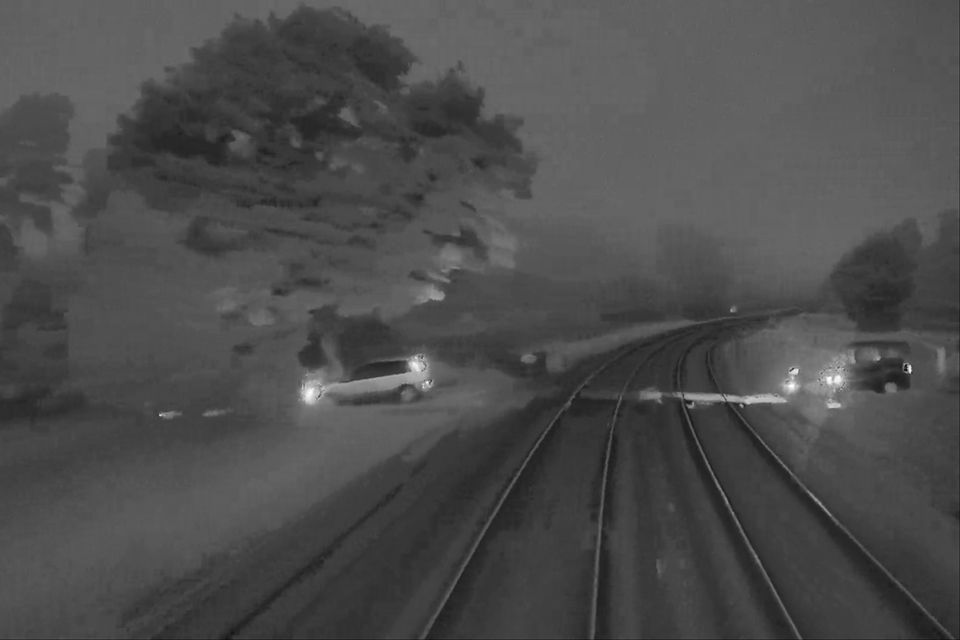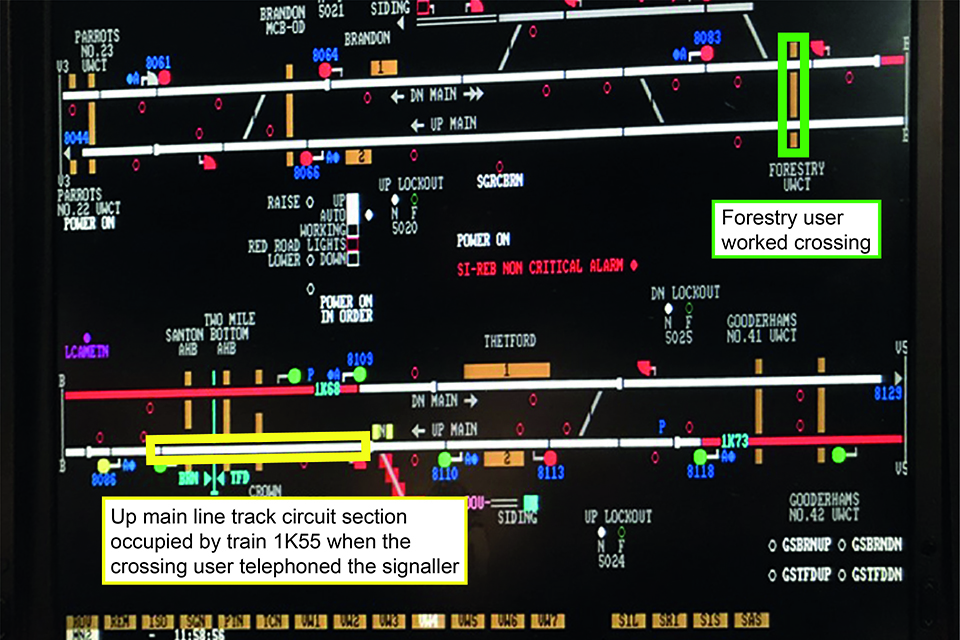Near miss at Forestry user worked crossing, Norfolk, 18 September 2021
Published 13 December 2021
1. Important safety messages
This incident highlights:
-
the importance of Network Rail continuing to focus management attention on reducing the risks associated with signallers’ decisions about granting permission for users to cross at user worked crossings with telephones, particularly in ensuring that signallers are provided with, and make use of, suitable information on which to base these decisions
-
how signallers’ awareness of the position of trains can be influenced by distractions, with potential effects on their safety critical decisions.
2. Summary of the incident
At around 06:05 hrs, a near miss occurred at Forestry user worked level crossing located between Thetford and Brandon. Train 1K55, the 05:27 hrs Greater Anglia service from Norwich to Stansted Airport, travelling on the up main line, came close to striking two cars. One of these cars had already crossed the tracks when the train entered the crossing. However, because the driver had not opened the gate on the far side of the tracks before crossing, this car was unable to move away, and remained within the railway boundary as the train passed.
The second car involved was inside the railway boundary on the other side of the crossing and was waiting to cross when the train passed. Although both cars were within the railway boundary, they were clear of the line itself, and the train passed between them without causing any damage or injury.
The train approached the crossing at about 76 mph (122 km/h) and the driver applied the brakes about 65 metres before reaching the crossing. This slowed the train to about 74 mph (119 km/h) at the crossing itself. The driver continued to brake until reaching a speed of 19 mph (31 km/h) and continued to travel around this speed until making the train’s next scheduled stop at Brandon station, around three-quarters of a mile (1.2 km) beyond Forestry user worked crossing.

Still image from train 1K55’s forward-facing CCTV, showing the location of the cars (crossing from right to left) at the time of the near miss (image courtesy of Abellio Greater Anglia)
3. Cause of the incident
There are telephones fitted at Forestry user worked crossing for users who are crossing with vehicles to contact the signaller and ask for the required permission to cross. This is a necessary part of the safe use of the crossing. These telephones connect to the signaller on the Thetford workstation at Cambridge signal box, who checks whether it is safe for users to cross, depending on whether any trains are approaching the crossing, and grants or denies permission to them accordingly.
At around 06:05 hrs on the morning of the incident, one of the car drivers used the telephone to ask for the signaller’s permission for both cars to cross. The user who telephoned said this would take two minutes. The signaller, having checked the signalling display, granted permission for the users to cross without realising that train 1K55 was approaching the crossing.
The Thetford workstation is a computer-based signalling display comprising five screens, which together present a schematic layout of the railway lines from Wymondham to Shippea Hill. Each screen represents the railway lines in white, divided into sections according to the track circuits that form part of the signalling system. Because the display is schematic, the lengths of the sections on the screens are not representative of their actual length in the real world. When a train occupies a given section, that section changes from white to red and includes a label showing the train’s reporting number.
When the crossing user made the request from the crossing, train 1K55 had passed Thetford station and was occupying a track circuit section between the station and Forestry user worked crossing. RAIB calculated that this section is about 5.64 miles (9.08 km) long, meaning that a train travelling at the maximum permitted linespeed of 90 mph (145 km/h) would take around 3 minutes and 46 seconds to traverse its length. On leaving this section, trains approaching the crossing pass into two shorter track circuit sections, before occupying the section which includes Forestry user worked crossing. When he checked the display and gave permission for the users to cross, the signaller believed that train 1K55 had only recently departed from Thetford station and, given the length of that track circuit section, that there would be enough time for the users to cross before the train arrived at the crossing.

The Thetford workstation screen. Note that this image does not represent the situation at the time of the incident (image courtesy of Network Rail)
However, RAIB’s analysis concluded that at the time the signaller gave permission for the users to cross, train 1K55 was actually nearing the far end of this track circuit, and was only around 44 seconds from Forestry user worked crossing. In fact, by the time the signaller had recorded the crossing request in the level crossing occurrence book, the train had already moved past Forestry user worked crossing and was occupying the track circuit section which includes Brandon station.
The signaller had booked on for duty at 05:38 hrs that morning, 22 minutes earlier than his scheduled shift start time. He used that time to carry out a verbal handover with the outgoing signaller, read various notices about planned work for that day, and start familiarising himself with activity on the workstation. According to witness evidence, the signaller was in this latter stage of building up his awareness when he received the call from Forestry user worked crossing around 06:05 hrs. Train 1K55 was the only train shown on the workstation at the time, and RAIB considers that the signaller’s continuing focus on understanding the wider situation on the workstation may have affected his perception of the train’s position.
In addition, the long track circuit section between Thetford station and Forestry user worked crossing did not, in itself, lead to the signaller having enough information about the train’s position to allow him to make an informed decision about when it would reach the crossing. The signaller stated that there are no formal criteria for making the decision to grant permission to cross, and it is a matter of signallers’ judgement and expertise. The signaller stated that he usually used the activation of the automatic half barrier level crossing at Two Mile Bottom as an indication that a train was too close to allow a user to cross at Forestry user worked crossing. Although on this occasion he could not recall checking the status of Two Mile Bottom crossing, RAIB’s analysis has concluded that train 1K55 had already passed it when the signaller made the decision that it was safe for the users to cross, meaning that this indication would have been in any case ineffective. The signaller stated that it is also possible to click on the reporting number of the train on the workstation display for information about its last timing point (in this case, Thetford station), but that he again did not do so on this occasion.
4. Previous similar occurrences
In 2017 RAIB published its report into the accident which occurred on 10 April 2016 at Hockham Road user worked level crossing (RAIB Report 04/2017). This crossing lies between Harling Road and Thetford stations, and is also covered by the Thetford workstation of Cambridge signal box. One of the causal factors of the Hockham Road accident was similar to the incident at Forestry user worked crossing, in that the signaller lost awareness of the position of the train and gave permission for a user to cross when there was insufficient time before the train arrived at the crossing.
One of RAIB’s recommendations in the Hockham Road report was for Network Rail to review its measures for protecting user worked crossings, with the objective of reducing the likelihood that an accident will be caused by signaller error. The recommendation set out options for consideration, including improved information to enable signallers to judge the time needed for a movement over a crossing against the time available before a train arrives. Network Rail responded to this part of the recommendation by reporting that it had implemented a new national procedure to assist signallers in making decisions at user worked crossings. The Office of Rail and Road told RAIB that it considered that this recommendation had been implemented by Network Rail, based in part on the information that this new procedure had been implemented. However, Network Rail told RAIB that the new procedure was still under review at the time of the incident at Forestry user worked crossing and was not due to be published until early 2022.
Network Rail also carried out a number of other actions to address the recommendations arising from the Hockham Road investigation, some of which have relevance to the incident at Forestry user worked crossing. Two additional screens were commissioned on the Thetford workstation (bringing the total to the five that were in place at the time of the incident), providing more detail on the displays, while the labelling of crossings on some screen views was made clearer. In addition, Network Rail reviewed the rules surrounding signallers’ granting permission to users at user worked crossings, and rebriefed the rules to all staff in Cambridge signal box.
Several near misses at other user worked crossings have been the subject of RAIB reports and safety digests. These incidents have involved similar causal factors to the incident at Forestry user worked crossing, including problems with long track circuit sections (near miss at Dock Lane, Suffolk, 14 June 2016, RAIB report 08/2017), lack of clarity around the decision criteria for user worked crossings (serious irregularity at Bagillt, Flintshire, 17 August 2018, RAIB report 11/2019), and the type of information shown on the signaller’s display to support decisions about user worked crossing (near miss at Worlingham, Suffolk, 8 June 2020, RAIB safety digest 07/2020).
Following the incidents at Hockham Road and Dock Lane, the Office of Rail and Road served two improvement notices on Network Rail requiring it to improve its control of the risks at user worked crossings on the Anglia route. The first improvement notice required that Network Rail identify user worked crossings with telephones where there was a risk to users due to long track circuit sections and signallers not having an accurate knowledge of the location of trains approaching the crossing. The second improvement notice specified actions to be taken at those crossings and signal boxes identified in the first improvement notice. In a review undertaken to comply with the first improvement notice, Network Rail did not identify Forestry user worked crossing as one of those at risk, and so the actions taken in response to the second improvement notice were not applied there.

